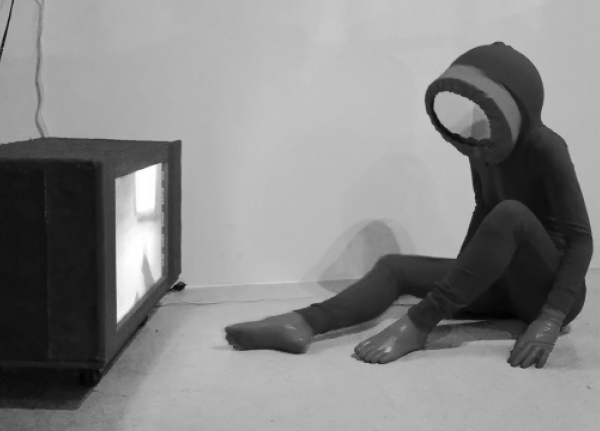
RED VIEWER
first performed on September 19, 2017
Robert Miller Gallery space, New York, NY
performed three times in 2017
KS BREWER
Brooklyn, NY
750534465k750534465e750534465l750534465s750534465e750534465y750534465s750534465b750534465r750534465e750534465w750534465e750534465r750534465@750534465g750534465m750534465a750534465i750534465l750534465.750534465c750534465o750534465m
kelseysbrewer.com
RED VIEWER
KS BREWER
“Red Viewer” is a 30-minute performance that speaks to voyeurism, surveillance, the male/female gaze, and subject/object relationships.
Wearing a bright red jumpsuit, latex gloves, toe socks and a mirrored helmet, I become the anonymous Red Viewer. I am entirely hidden behind my red facade, but simultaneously exposed by it. The tight suit reveals the shape of my body, the bright color draws attention, and latex details offer an element of kink. A silver cable runs from my neck like a second spine and connects to a red velvet box on wheels that houses a television screen. This TV displays a live video feed of whatever I can see from inside my mirrored helmet. As I slowly contort my body, and engage with people surrounding me, these viewers can simultaneously see themselves reflected in my mirrored helmet as well as recorded and displayed on the screen. If I look at the screen, the image compounds—the unsettling effect of two mirrors facing off with our own image trapped in between. While the TV acts as my sword, aggressively capturing images of others, my mirrored “face” acts as my shield; I refuse to allow participants a glimpse of me, and instead deflect their gaze back at themselves. However, the audience brings their own weapons to this interaction: as I record them, they often record me through their own devices. Simultaneously hidden and exposed, object-like and human, observer and observed, this exposed relationship, emphasized by my anonymity, is what gives the performance its power.
“Red Viewer” is designed to draw the audience in as voyeurs, then deflect their gaze back for self-reflection. For the duration of the performance, they are forced to locate themselves within the vertiginous and unsettling reflective space. What does it mean to be watched? In what cases is it empowering or demeaning? What does it mean to be a voyeur or an exhibitionist? What does it mean to play the role of object, or treat others as one? In this age of profound relationships to screens, government surveillance, and public acknowledgement of women’s treatment in society, the assessment of our own relationship to these issues is of crucial importance. My hope is that, in playing out this complex performer/audience dynamic, participants see their own image in a new light.